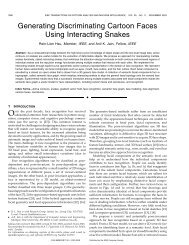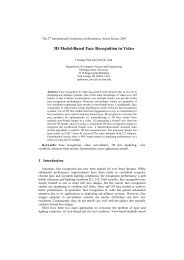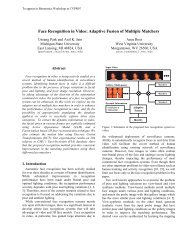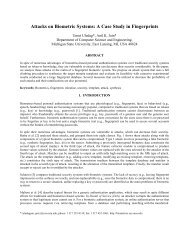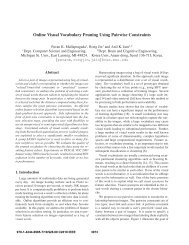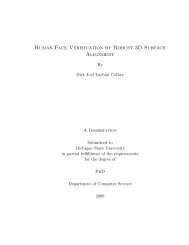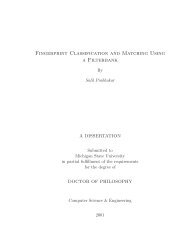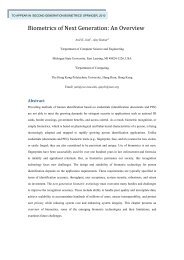Face Detection and Modeling for Recognition - Biometrics Research ...
Face Detection and Modeling for Recognition - Biometrics Research ...
Face Detection and Modeling for Recognition - Biometrics Research ...
Create successful ePaper yourself
Turn your PDF publications into a flip-book with our unique Google optimized e-Paper software.
sume that the face images have been captured at near frontal views (i.e., all of internal<br />
<strong>and</strong> external facial components are visible). The face alignment module makes use of<br />
the face detection results to align a semantic face graph onto the input image. The<br />
face alignment can be decomposed into the coarse <strong>and</strong> the fine alignment modules.<br />
In the coarse alignment, a semantic face graph at an estimated pose is aligned with<br />
(a) (b) (c) (d)<br />
Figure 5.4. <strong>Face</strong> detection results: (a) <strong>and</strong> (c) are input face images of size 640 × 480<br />
from the MPEG7 content set; (b) <strong>and</strong> (d) are detected faces, each of which is described<br />
by an oval <strong>and</strong> a triangle.<br />
a face image through the global <strong>and</strong> local geometric trans<strong>for</strong>mation (scaling, rotation,<br />
<strong>and</strong> translation), based on the detected locations of face <strong>and</strong> facial components. Section<br />
5.3 will describe in detail the fine alignment, in which the semantic face graph<br />
is locally de<strong>for</strong>med to fit the face image.<br />
Coarse alignment involves a rigid 3D trans<strong>for</strong>mation of the entire semantic graph.<br />
The parameters used in the trans<strong>for</strong>mation (scaling, rotation, <strong>and</strong> translation) are<br />
estimated from the outputs of the face detection algorithm. Besides the use of face<br />
detection results, we further employ the edges <strong>and</strong> color characteristics of facial components<br />
to locally refine the rotation, translation, <strong>and</strong> scaling parameters <strong>for</strong> individual<br />
components. This parameter refinement is achieved by maximizing a semantic<br />
facial score (SFS) through a small amount of perturbations of the parameters. The<br />
semantic face score takes into account the fitness of component boundary <strong>and</strong> of com-<br />
116



